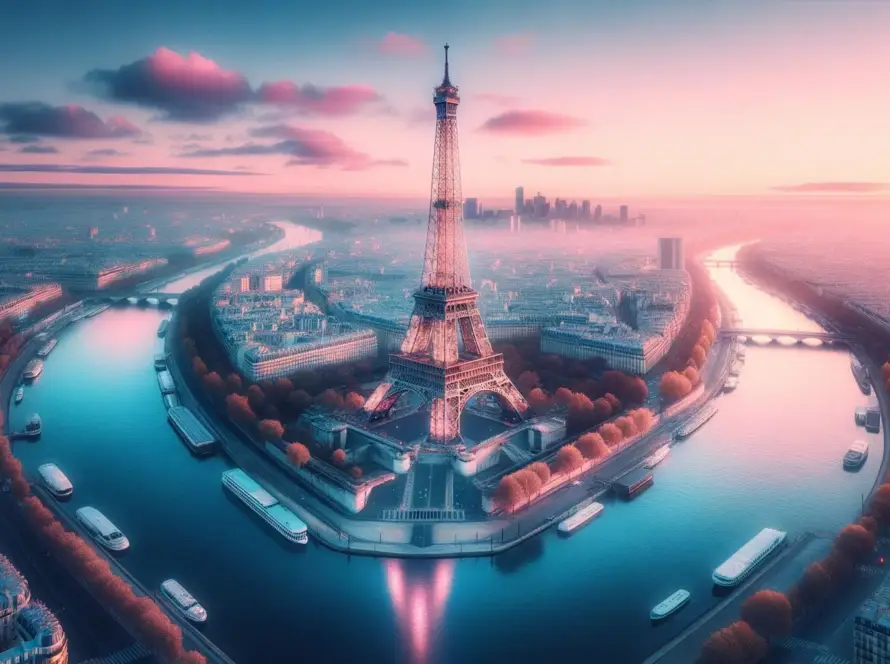Generated by Contentify AI
- Origins and Construction
- Architectural Design
- Significance and Cultural Impact
- Renovations and Preservation Efforts

Origins and Construction
The Eiffel Tower, an emblem of Paris and a masterpiece of iron architecture, stands as a testament to innovative engineering and design. The journey of its creation began in the late 19th century, when the French government announced a competition for a centerpiece for the 1889 Exposition Universelle, a world’s fair to commemorate the centennial of the French Revolution. Out of more than 100 proposals submitted, the design by engineer Gustave Eiffel, along with Maurice Koechlin and Émile Nouguier, was selected for its daring and originality.
Construction of the tower commenced on January 28, 1887, and was a marvel of precision and efficiency, considering the technological constraints of the era. Over two years, two months, and five days, a workforce of 300 laborers assembled the 18,038 pieces of puddled iron, using over 2 million rivets, without a single fatal construction accident—a remarkable achievement of its time. Initially met with skepticism and criticism from some of Paris’s leading artists and intellectuals, who deemed it an eyesore, the structure was intended to stand for 20 years before being dismantled.
However, the completion of the Eiffel Tower for the Exposition Universelle of 1889 was a monumental success, attracting millions of visitors and quickly becoming a symbol of French creativity and industrial prowess. Originally standing at 300 meters (984 feet), it was the tallest man-made structure in the world at the time, a title it held until the completion of the Chrysler Building in New York in 1930. The history of the Eiffel Tower, from its conception to its construction, showcases not only the architectural ambition of its creators but also the beginning of a new era in construction and design, marking the tower as an indelible icon of Paris and the industrial age.
Architectural Design
The architectural design of the Eiffel Tower is a feat of engineering that has captivated imaginations since its inception. Conceived by Gustave Eiffel and his team as a temporary exhibit for the 1889 Exposition Universelle, the structure’s intricate lattice work was a radical departure from traditional architectural styles of the time. Its design was revolutionary, leveraging the properties of wrought iron to create a structure that was both lightweight and incredibly strong. This was a pioneering moment in the history of architecture, demonstrating the potential of iron as a primary construction material.
Spanning a base area of 125 meters on each side and soaring to a height of 300 meters, the tower’s design incorporated over 18,000 individual metal parts, joined together by 2.5 million rivets. This modular approach not only facilitated the swift construction process, completed in just over two years, but also contributed to the tower’s unique aesthetic, which was initially met with mixed reactions. Critics at the time described it as a ‘monstrous eyesore’, yet the design has since become synonymous with innovative architecture and is celebrated worldwide for its elegance and distinctiveness.
Central to the Eiffel Tower’s design is its functional adaptability, which has allowed it to serve various purposes over the years, from a scientific research platform to a military radio broadcasting tower. This utility, combined with its architectural novelty, solidified the tower’s place in the annals of architectural history, making it a subject of study and admiration within the field.
The tower’s three platforms were designed to accommodate visitors, with the second tier famously housing Gustave Eiffel’s private office. The panoramic views of Paris offered from these vantage points have made the Eiffel Tower a must-visit landmark, drawing millions of tourists annually. Its architectural design, emphasizing both form and function, has ensured that the tower remains at the forefront of discussions on the evolution of modern engineering and architecture. This blend of innovation and beauty is what anchors the Eiffel Tower’s significant place in the history of the Eiffel Tower and its enduring appeal as a symbol of French creativity and ingenuity.
Significance and Cultural Impact
The significance and cultural impact of the Eiffel Tower cannot be overstated. Since its completion, it has transcended its initial role as a temporary exhibit for the 1889 Exposition Universelle to become a global symbol of France and a beacon of Parisian splendor. This remarkable transformation in public perception is a testament to the tower’s enduring allure and its place in the cultural and historical fabric of France. The Eiffel Tower has played a pivotal role in inspiring artists, writers, and filmmakers, making frequent appearances in literature, paintings, and movies, thereby embedding itself in the global cultural consciousness.
The tower’s impact extends beyond the realms of art and entertainment; it has become an icon of French innovation and the spirit of the Industrial Age. Its image is instantly recognizable and often evokes the romance and charm associated with Paris. The Eiffel Tower has also been a site of significant historical events, including being the focal point of various exhibitions, celebrations, and, during darker times, a symbol of resistance during World War II. Its use as a radio transmission tower during the war highlighted its strategic importance, further cementing its place in French history.
In contemporary times, the Eiffel Tower continues to play a crucial role in Paris’s cultural and social events, including national celebrations such as Bastille Day, when it is the centerpiece of spectacular fireworks displays. It also serves as an important gathering place for public expressions of joy, mourning, and solidarity, reflecting the collective sentiments of both the city and the nation.
The Eiffel Tower’s image is leveraged by France in promoting tourism, making it the most-visited paid monument in the world. This, in turn, has significant economic implications for the city and the country, showcasing the tower’s role in not only cultural but also economic spheres.
In sum, the cultural impact and significance of the Eiffel Tower in the history of the Eiffel Tower are profound. It stands not just as a marvel of engineering but as a monument that captures the imagination, symbolizes human achievement, and embodies the heart and spirit of Paris and France. Its story from a controversial structure to a cherished symbol illustrates the power of architecture to influence culture, history, and even national identity.
Renovations and Preservation Efforts
Throughout its existence, the Eiffel Tower has undergone numerous renovations and preservation efforts, crucial for maintaining its status as a symbol of architectural marvel and cultural significance. These efforts ensure the tower’s endurance against the elements and the wear of time, allowing it to greet millions of visitors each year with the same splendor it has showcased since the 19th century. Initially, the iron structure was vulnerable to rust and required constant attention, leading to the establishment of a rigorous maintenance schedule. Every seven years, the tower undergoes a complete repaint, a task that requires 60 tons of paint to protect its ironwork from corrosion. This process is not only a matter of preservation but also adheres to Gustave Eiffel’s original vision for the tower’s longevity.
The renovation projects have also included the installation of modern amenities to enhance visitor experience without compromising the tower’s historic integrity. Over the years, the tower has seen the addition of lifts, updated lighting for nighttime illumination, and the installation of broadcasting equipment, transforming it into a modern beacon of communication.
In recent years, the focus on sustainability and accessibility has led to significant updates. Efforts to reduce the environmental impact include the installation of solar panels, rainwater collection systems for restroom facilities, and wind turbines, showcasing a commitment to energy efficiency. Moreover, the tower’s first floor underwent a significant renovation in 2014, introducing glass floor panels that offer a breathtaking view of the city below, along with other structural improvements to enhance safety and accessibility for all visitors.
The history of the Eiffel Tower is not just a tale of architectural achievement but also a story of ongoing care, adaptation, and respect for heritage. These renovations and preservation efforts are a testament to the tower’s enduring legacy, ensuring that this iconic structure remains a symbol of French innovation and a source of national pride for generations to come. Through these continual updates, the Eiffel Tower remains a dynamic monument, bridging the past with the future in the heart of Paris.



